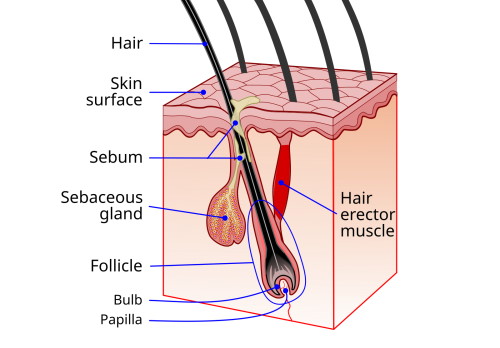An infected ingrown hair can in rare cases become life-threatening. Learn how to make sure this never happens to you.
A story spreading on social media might show how a seemingly innocuous health issue — an infected ingrown hair — can in rare cases lead to serious and even life-threatening complications.
As detailed on TikTok and by various media outlets, Steven Spinale, a 36-year-old man from Texas, was hospitalized in October 2022 when a rare bacteria infected his bloodstream and caused his organs to begin shutting down.
Spinale and his family suspected that the infection began when he tried to remove an ingrown hair from his groin area. An ingrown hair is a strand that grows back into the skin, often after shaving, tweezing, or waxing.
BREAKING: Men Try This Tonight - You'll Never Need The Pill Again
After being admitted to the hospital, Spinale caught the flu and developed double pneumonia. His blood infection progressed to the point where Spinale went into septic shock.
Septic shock is a life-threatening complication of sepsis, which is an extreme reaction to infection that leads the immune system to turn on itself and cause widespread inflammation.
“He declined fast until he crashed and was put on life support,” wrote Spinale’s sister Michelle on a GoFundMe page that shared his ordeal.
At one point, Spinale was declared brain dead, and given a 4 percent chance to live. When the infection eventually reached his heart, he was put into a medically induced coma and underwent open heart surgery.
Three weeks post-surgery, Spinale began to revive. By the end of November, he was sitting up and smiling in his hospital bed.
But the road to recovery has been slow, and in a social media post a year later, in the fall of 2023, Spinale was still in physical therapy, regaining strength to move on his own with the help of a walker.
How Can an Infected Hair Lead to a Serious Infection?
Although Spinale’s case is highly unusual, Spencer Hawkins, MD, a dermatologist at Advanced Dermatology and Cosmetic Surgery in East Greenwich, Rhode Island, and the editor of HairMedicine.org, warns that an ingrown hair can become concerning if not treated properly.
“If bacteria spreads beneath the skin or into the bloodstream, it can lead to more serious infections like cellulitis or, in very rare cases, sepsis,” says Dr. Hawkins. “People with weakened immune systems or underlying health conditions are at a higher risk of complications.”
While an infection can come from an ingrown hair itself, bacteria on hands, tweezers, or other implements used to remove the hair can also be a cause.
“When an ingrown hair enters the skin, the body’s immune system views the hair as a foreign substance, like a virus or bacteria, since it’s not in a hair follicle,” says James Pathoulas, MD, a resident physician in dermatology at Stanford Medicine in California. “This triggers inflammation and skin breakdown, giving bacteria an opportunity to break through the skin barrier and cause infection.”
Any time there is a bacterial infection in the body, there is a chance that the germs can enter the bloodstream and travel throughout the body, potentially causing sepsis.
What an Infected Ingrown Hair Looks Like and What to Do About It
An infected ingrown hair will typically appear as a swollen bump on the skin, resembling a pimple. It may be filled with pus and can be tender or painful to touch.
“The area around it can be inflamed and might feel warm,” says Hawkins.
To safely treat an ingrown hair, the Cleveland Clinic recommends gentle exfoliation to remove dead skin and release the hair. This requires cleansing the affected area with warm — not hot — water and small, circular motions with a washcloth, exfoliating brush, or exfoliating gel or scrub.
Visible ingrown hairs may be released by inserting a sterile needle under each hair loop and gently lifting the tip that has grown back into the skin.
Most ingrown hairs go away on their own one to two weeks, but if there is pus, discoloration, and pain, it’s important to see a healthcare provider. If pain worsens, infection appears to spread, or a fever develops, seek immediate medical help.
In some cases, a doctor may prescribe antibiotics to help stop the spread of infection, according to Dr. Pathoulas.
How to Prevent Ingrown Hairs
To avoid ingrown hairs and any potential complications, Hawkins offers the following tips:
TRENDING: This Keeps Your Blood Sugar Below 100 - Even When You're Eating Sweets!
- Utilize proper shaving techniques. Using a sharp, clean razor and shaving cream or gel, shave in the direction of hair growth.
- Exfoliate regularly to remove dead skin cells that could trap hairs.
- Keep skin moisturized to maintain its barrier function.
- Avoid tight clothing that can irritate the skin and hair follicles.
- Consider alternative hair removal methods, such as laser hair removal, especially if you’re prone to ingrown hairs and infections.
- Consistently use a benzoyl peroxide or hypochlorous acid wash to reduce bacteria on the skin.
If ingrown hairs are a recurring problem, or if infections are frequent or severe, you may want to consult a dermatologist for more personalized advice or treatment options.
As Michelle Spinale shared on TikTok, people need to be extremely vigilant when it comes to infections.
“Infections can happen at any time and become deadly,” she says.








